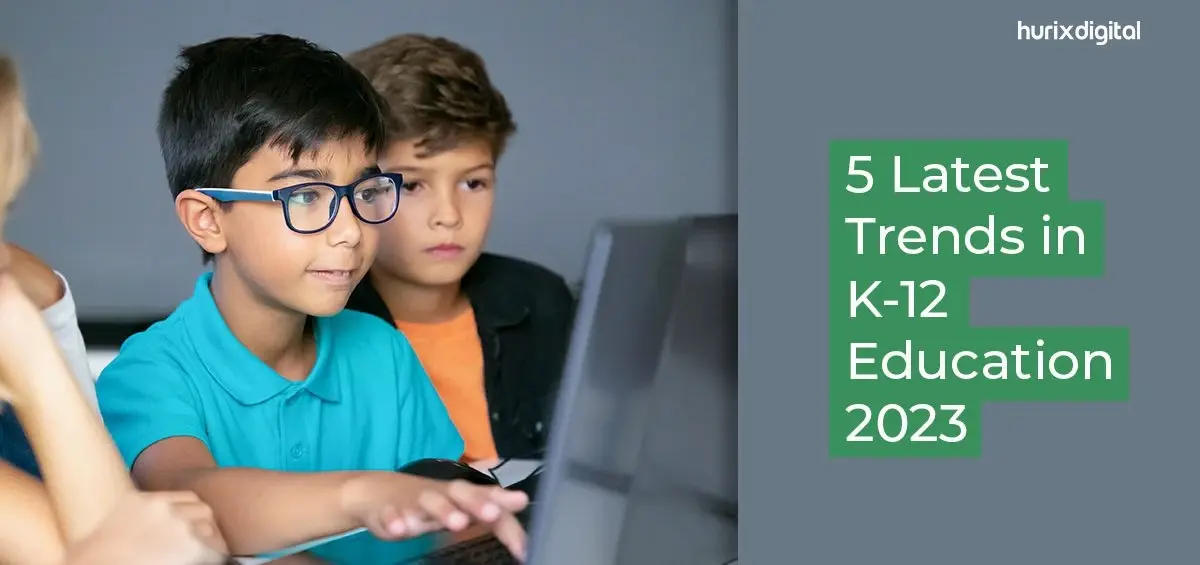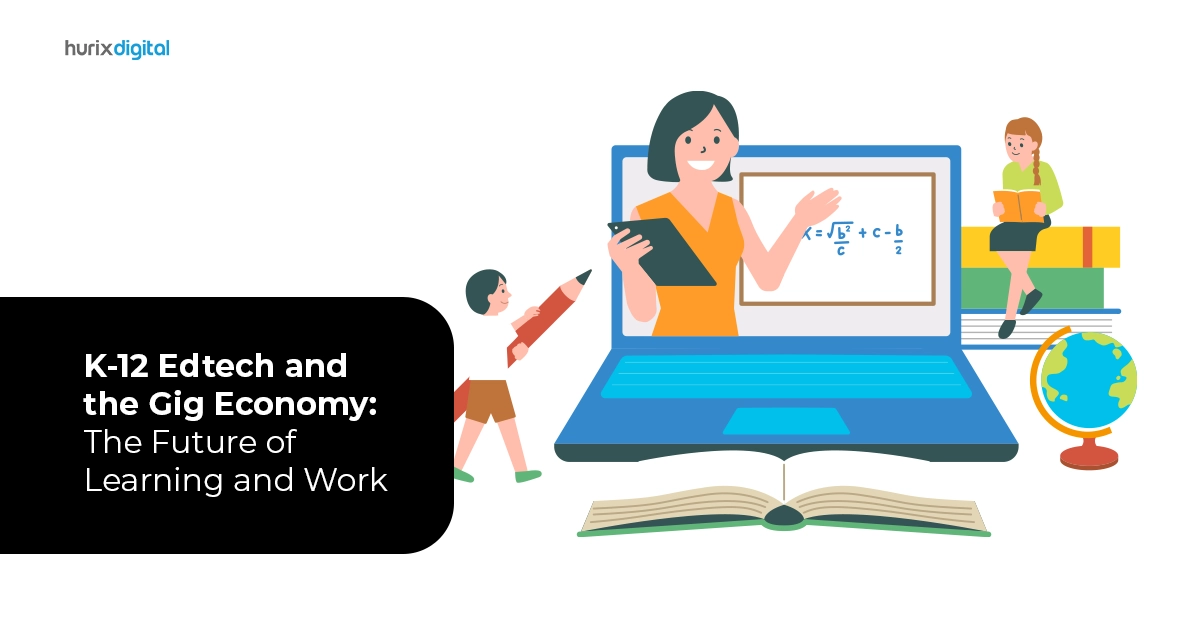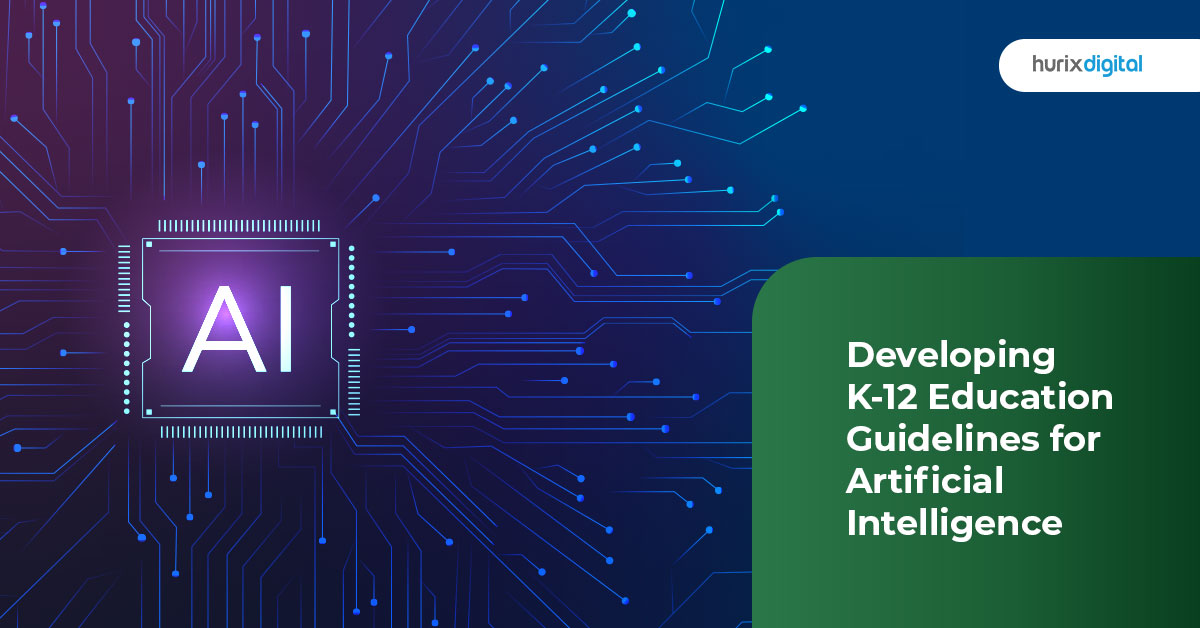
5 Latest K12 Education Trends for 2025
Summary
The blog explores the evolving landscape of K12 education, accelerated by the pandemic, with technology at its core. It highlights five key trends for 2025: immersive technologies, individualized learning, subscription-based education, gamified learning, and nano-learning, reshaping educational paradigms worldwide.
Technology has a big role to play in amending the entire system of K12 education and bringing around only the perks of schooling to children. The influence of technology in K12 education can be understood by looking at three figures – 93%, 81%, and 58%.
Confused about what these figures are all about?
Here’s the information you need to clear up your confusion:
- In a survey, 93% of participants confessed that they had conducted online teaching in some form before the summer of 2020.
- % of US school teachers admitted that their familiarity with educational technology and online tools skyrocketed due to the pandemic.
- In another survey, 58% of participants confessed that they feel more confident about educational technology and online tools than ever.
At this point, it might seem natural to draw a common conclusion that the K12 Education system is the consequence of the pandemic.
However, much to the surprise of many, technology penetrated K12 education and was introduced far before the virus broke out globally. Irrespective of the purpose of such technology, it is indelible that the COVID-19 disaster was the catalyst for promoting the role of technology in the K12 education system.
Moreover, this new system appeared to be more sustainable and convenient for students and teachers.
So, now that the pandemic is over and the K12 education system has become more technology-driven, what are the 5 significant education trends we expect in 2025? Dive deep into this article to get a comprehensive answer.
Table of Contents:
- Latest K12 Education Trends: The Basic Premise
- Top 5 K12 Education Trends [From 2025 & Beyond]
- How do Digital Content Platforms Contribute to K12 Education Market Trends in 2025
- Role of Technology in Trends for 2025 in K12 Education
- Conclusion
Latest K12 Education Trends: The Basic Premise
Before exploring the top 5 trends in education technology in 2025, it is important to understand the basic premise of K12 education in 2024:
- Virtual media can be used in any educational course: Through digital learning tools, faculty members can speed up learning across the spectrum, whether students are learning face-to-face, online, or through the blended mode.
- It benefits investors: The practical benefits of integrating K–12 education technological toolkits into their classes and curricula are being recognized by educational institutions all around the world. In the ongoing and prospective training environment, 85% of instructors and 71% of administrators see enormous benefits in technological resources, while more than 80% of university students credit their improved scores to online courses.
- Communication is pertinent: Communication is the key to success and every vital aspect of success. It is readily observed that digital schooling has increased the scope of interaction between teachers and students.
Let us now shift our attention to the five top digital trends expected to affect K12 education in 2025.
Also Read: Ingenious Ways of Personalizing the K12 Online Learning Experience with AI
Top 5 K12 Education Trends [From 2025 & Beyond]
The K12 landscape is changing faster, with 2025 being hailed as the year of transformational change. In this article, let’s explore the top future trends in K12 education that have transformed classrooms and improved learning outcomes.
1. A Productive Blend of REAL, AR, AI, and VR
Humankind is gradually getting acclimated to receiving attractive content in the blink of an eye. Learning is undoubtedly not atypical when it comes to how Reality, Augmented Reality (AR), Artificial intelligence (AI), and Virtual Reality (VR) will influence all individual activities.
Simply put, as these technologies make their way into all aspects of human life, the socio-educational infrastructure will follow suit and imbibe these technologies into all facets of K12 education.
As AI, AR, and VR tools become more human-centric and technologically advanced, K12 education stakeholders can use such advancements to simplify personalized or remote learning for every student in classrooms.
2. Individualized Learning Leads to Better Outcomes
There was an era where parents seemed to have no issues with one teacher assigned to a class of 40-70 students. Well, those practices are long gone.
Personalized learning is gradually transforming into individualized learning, and it is increasingly taking hold as the latest trends in education indicate.
The difference between personalized and individualized learning is that while personalized learning focuses on making education more interesting for learners, individualized learning analyzes each student’s unique traits and designs content in a way that appeals to their senses.
K12 education stakeholders can also take the help of technologies like AI and ML (Machine Learning) to aid the transition from personalized learning to individualized learning.
One of the top 4 trends for education in 2025 that has been slowly gaining popularity is homeschooling. In this method, parents teach their kids at home instead of enrolling them in a formal or informal institution of higher learning.
In 2025, we can expect more parents to join the fray in designing original curricula and devising effective teaching techniques for their kids.
3. Perpetual Education through Subscriptions and Memberships
The schooling system was very diverse merely a few generations ago. With the speed at which technology is developing, educators and students are embracing subscription-style models of online classes.
For students seeking out adaptable methods of integrating instructions, the rise of online learning providers features inclusive classroom sessions alongside conventional training sessions. Their primary educational model is now online learning.
Among the styles that will continue to be popular in 2025 is this particular one because it was created to meet the evolving requirements of organizations fully.
Long story short, educational content delivery platforms like Hurix will enter more K12 institutions. Hurix Digital provides education stakeholders with an all-in-one Learning Management System (LMS) to simplify classroom or online teaching. Teachers can upload many different lessons, such as PDFs, docs, excel files, videos, images, etc., and control who can see the content and who cannot.
So, as subscription-based educational services become mainstream, platforms like Hurix will become more innovative in pursuing the cause of individualized learning.
4. Game-Based Learning Will Become the Norm Rather Than an Exception
Kids nowadays are very familiar with edutainment. It has been circulating in the K12 education segment for a while and successfully announcing its existence.
The year 2025 will explore the positive benefits of gamified learning even more. Playing educational games will provide an immersive method of information literacy by involving students in their studies and promoting greater multimodal involvement.
The fact for the forthcoming future of education is that keeping pace with innovation is now a requirement, not a choice, to respond to the growing technology trends. As learning competency is rapidly adaptable and more appealing today, these approaches will certainly gain prominence in the coming year.
5. Use of Nano-Learning in Schooling
Nano-learning in EdTech is a fresh concept. Although corporate organizations have been using it for quite some time, the K12 education industry has yet to introduce it.
You can understand nano-learning better if you know the basic premise of Instagram Reels or YouTube Shorts. Like how Instagram Reels or YouTube Shorts deliver bite-sized content within 15 seconds, teachers use the same technique to deliver educational content to students.
How do Digital Content Platforms Contribute to K12 Education Market Trends in 2025
Digital content platforms are an important part of the evolution of market trends in K12 education in 2025. They are paving innovative ways for learning, simplifying administrative tasks, and bridging gaps in the delivery of education.
Here are some ways in which they contribute to market trends:
1. Personalized and Adaptive Learning
Digital tools use AI and data analytics to show the student content based on their needs and learning habits. This personalization corresponds to the future ideas of K12 education and causes effective learning using:
- Lessons automatically adjust based on the child’s progress.
- Automated quizzes and assessments based on the strengths and weaknesses of the student.
2. Access Resources at Central Place
Digital content platforms combine textbooks, multimedia, interactive lessons, and supplementals. Students can view materials at any time, from anywhere, further reinforcing hybrid and remote learning. This promotes fewer physical books and a reduction in printing, further updating the K12 education cost-consciousness needs.
3. Collaboration and More Engagement
Online platforms with interactive capabilities make collaboration among peers and between teachers and students possible. This encourages real-time interaction through video, chats, and shared documents. Game-based learning modules increase interest and participation in current trends in elementary education.
4. Data-Driven Insights for Teachers
These solutions offer analytics and reporting for data-driven decisions. Such platforms help detect students who lag quickly and implement intervention strategies on time. They also allow educators to track the effectiveness of content and adapt lessons accordingly. This feature comes under the tech trends for K12 schools where data-driven education can help improve quality.
5. Compatibility with CRM for K12 Education
Digital content in K12 institutions is aligned with a CRM to manage operations in K12 schools. This includes real-time updates of performance and activity, which encourages progress monitoring. It helps link dashboards in the same view for teachers and administrators, monitoring student academic and behavioral data.
Role of Technology in Trends for 2025 in K12 Education
The role of technology in future trends in K12 education is set to transform how students learn and how teachers teach. By 2025, classrooms will be fully integrated with the most advanced tools that will boost learning efficiency and engagement.
The following are some important elements of the transformation:
- Virtual and Augmented Reality (VR/AR): VR/AR tools create immersive learning experiences, making complex concepts easy to understand using hands-on simulations and visualizations.
- Gamified Learning: Game-based learning systems have been significantly increasing students’ motivation and participation, a trend well in line with current trends in elementary education.
- Digital Content Platforms: It provides easily accessible centralized access to interactive learning content, which enables student real-time and teacher coordination with seamless tracking.
- Personalized Learning: These systems analyze student behaviors, identify learning gaps, and recommend tailored study plans. For educators, AI helps streamline lesson planning and grading, allowing more time for direct student engagement.
- CRM Systems Transforming K12 Management: CRM for K12 education is an entirely new wave in the management and communication process within schools. How these systems help:
-
- CRMs provide an integrated central platform helping organizations with updates, meetings, and student progress reports.
- From attendance to performance tracking, CRMs ensure transparency and efficiency in managing student data.
- This automates all administrative workflows and enables schools to focus on the quality of education. By integrating with the tech trends of K12 schools, CRM systems let schools function very efficiently while ensuring individualized learning experiences.
Also Read: How K12 Learning Solutions Help Teachers and Students?
Conclusion
In conclusion, technology undeniably shapes the future of K12 education, and its influence will continue to grow through 2025 and beyond. From immersive tools like AR, VR, and AI to the rise of game-based education, these advancements promise to enhance student engagement and educational outcomes.
The continued integration of technology in K12 schools is setting the stage for a more dynamic, personalized, and efficient learning environment for the next generation, with platforms like Hurix Digital helping them achieve a seamless learning experience.
Now that you know the top five K12 education market trends, reach out to our experts for hi-tech K12 learning content solutions for 2025!

Senior Vice President – Business Development
Over 25 years of experience in the edtech and workforce learning industry with strong skills in Business Development, Customer Relationship Management (CRM) and Strategy.







